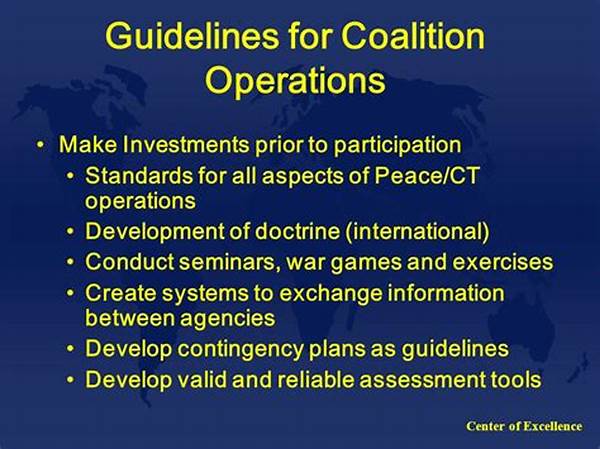In contemporary military operations, coalition warfare is an essential framework, bringing together diverse nations to achieve common objectives. This synergy necessitates a carefully crafted set of principles, known as coalition warfare operational guidelines. These guidelines are pivotal for fostering collaboration, ensuring interoperability, and achieving strategic goals. Understanding and adhering to these guidelines is crucial for the success of coalition operations, as they provide a foundational framework for coordination and effective execution of joint military actions. In the following sections, we delve into the intricacies of coalition warfare operational guidelines, exploring their significance, key components, and applications in the modern military context.
The Importance of Coalition Warfare Operational Guidelines
Coalition warfare operational guidelines are indispensable in creating a coherent and unified operational framework. They ensure that all participating forces operate under a common set of directives, which facilitates seamless interoperability. These guidelines encompass command structures, communication protocols, and rules of engagement, each tailored to accommodate the varying doctrines and operational methodologies of the coalition partners. Furthermore, they delineate logistical support and allocation of resources, ensuring equitable distribution and efficient utilization among participating nations. Without such guidelines, the risks of miscommunication and operational discord would significantly escalate, undermining the coalition’s mission. Ultimately, these guidelines serve as a strategic blueprint, ensuring collective military efforts are synchronized and directed towards a successful outcome.
Key Components of Coalition Warfare Operational Guidelines
1. Communication Protocols: Ensuring clarity and precision in communication among coalition forces is paramount. Adhering to standardized communication protocols mitigates the risk of misunderstandings and ensures aligned decision-making processes.
2. Interoperability Standards: Coalition warfare operational guidelines define the technical and procedural standards required for equipment compatibility and joint operations, fostering effective cooperation among diverse military forces.
3. Command and Control Structures: These guidelines establish command hierarchies and coordination mechanisms essential for maintaining a unified operational command, crucial for the success of coalition initiatives.
4. Logistics and Resource Management: Effective logistics planning and resource allocation are central to the coalition warfare operational guidelines, ensuring efficient supply chain management and equitable resource distribution.
5. Rules of Engagement: Clearly defined rules of engagement within the coalition warfare operational guidelines create a shared understanding of operational conduct, preventing potential conflicts and ensuring adherence to international laws.
Implementation of Coalition Warfare Operational Guidelines
The implementation of coalition warfare operational guidelines requires meticulous planning and continuous coordination among participating nations. Central to this implementation is the establishment of joint command centers and liaison teams that facilitate communication and monitoring of operations. Pre-deployment training programs that emphasize cultural sensitivity and understanding of partner nations’ military doctrines are critical, as they mitigate potential frictions and enhance operational synergy. Moreover, regular joint exercises are paramount in testing and refining these guidelines, ensuring that coalition forces are well-prepared to face real-world challenges. Consequently, the rigorous and systematic application of coalition warfare operational guidelines is integral to achieving operational cohesion and success on the battlefield.
Advantages of Coalition Warfare Operational Guidelines
Challenges and Considerations
Despite their advantages, implementing coalition warfare operational guidelines presents several challenges. Variations in national policies, military doctrines, and technological capabilities can complicate coordination efforts. Moreover, political dynamics among coalition members may influence operational priorities, complicating consensus-building processes. To overcome these challenges, continuous dialogue and diplomatic engagement at both the strategic and tactical levels are essential. Establishing a common technological and doctrinal baseline through joint training exercises can mitigate disparities and enhance operational coherence. It is imperative for coalition partners to remain committed to transparent communication and mutual respect, maintaining the effectiveness and integrity of the collaborative endeavor.
Conclusion
In essence, coalition warfare operational guidelines are a critical instrument in orchestrating international military cooperation. They provide a structured framework that harmonizes diverse military efforts towards achieving shared objectives. While they enhance operational efficiency and foster international relations, their successful implementation requires commitment to overcoming inherent challenges. Through meticulous planning, rigorous training, and unwavering diplomatic engagement, these guidelines can significantly augment the success and effectiveness of coalition endeavors. Therefore, embracing and refining coalition warfare operational guidelines is imperative for modern military coalitions seeking to navigate the complexities of global security threats efficiently and cohesively.





